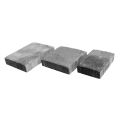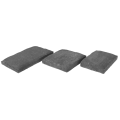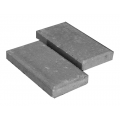RG+ Polymeric Jointing Sand
50lb Bags
TECHNISEAL RG+ POLYMERIC SAND is a state-of-the-art mix of graded sand (ASTM-C144) and binder that flows smootly down joints for a fast and effective installation of pavers or slabs on surfaces exposed to normal traffic. (For surfaces exposed to heavy traffic, wide joints, steep slopes and very humid areas use TECHNISEAL HP2 POLYMERIC SAND.)
Easy to use TECHNISEAL RG+ POLYMERIC SAND starts to set only a few minutes after being activated with water, and quickly becomes resistant to water erosion (rain, splashes, sprinklers, etc.). Now stronger, TECHNISEAL RG+ POLYMERIC SAND offers greater resistance to weed growth, insect invasion and erosion.
-MINIMUM JOINTS WIDTH: 3 mm (1/8")
-MAXIMUM JOINTS WIDTH: 2.5 cm (1")
-MINIMUM JOINTS DEPTH: 4 cm (1 1/2")
• Inhibits weed growth
• Deters ants and other insects
• Prepares pavers prior to protector application
• Stabilizes pavers - Follows movement
• Applied dry - becomes permanent after being activated with water
• Water-resistant 90 minutes after installation
BEFORE YOU BEGIN
Wear adequate protective clothing. To ensure the results will meet your expectations, always test the product on a small hidden area of approximately 4 sq. ft.
Weather conditions: Use product under dry weather and when there is no rain forecasted for 24 hours. Temperature should be above 40°F.
STEP 1. Installation:
1) The surface must be completely dry.
2) Spread the product uniformly over the surface.
3) Using a push broom, sweep the product so as to fill the joints completely, down to their full depth. Avoid sweeping the product over long distances, to preserve the integrity of the mix.
STEP 2. Compaction:
1) This step is essential to obtain solid, durable joints.
2) Pass a plate vibrator over the entire surface to fully firm up the joints.
3) Repeat steps 1 & 2 until the joints are completely packed. Joints must be filled up to the bottom of the pavers chamfer, or no higher than 1/8 inch below the top of the pavers.
STEP 3. Wetting:
Important: To avoid having the product stick to the surface of the pavers or slabs, surface must be free of the product.
1) Sweep the surface with a fine bristle brush and remove all residues with a leaf blower.
2) Produce a very fine mist so that the water falls gently without displacing the polymeric jointing sand. Moisten the section lightly and in a continuous manner. Wetting should take place in sections no larger than 500 sq. ft. at a time. Ensure that the wetting of one section is finished before another section is started. Avoid flooding the surface and causing a runoff.
3) Using a small screwdriver, verify the progress of the wetness in several areas by emptying a small portion of the polymeric jointing sand.
4) Once the joints are moistened 1.5 inch deep, stop watering the section and move on to the next one. Too much water will cause the binder to run off and prevent the sand from solidifying.
STEP 4. Drying:
To ensure optimal cohesion and long-term stability, polymeric jointing sand must dry completely before being exposed to water. In cases where the surface could be exposed to water during the drying period, protect it with a tarp. Remove the tarp as soon as the risk of exposure has passed.
Down time before using:Residential uses: No specific considerations. Motor-vehicle areas: 24 to 48 hours
Note: Drying time can be considerably less in dry climates but will be prolonged in cold and damp weather.
IMPORTANT:
Do not apply to wet or damp surfaces as the activation of the binder will make TECHNISEAL polymeric jointing sand stick to the surface and prevent it from flowing down into joints. Do not use if rain is forecasted. Do not mix TECHNISEAL polymeric jointing sand with cement or sand. Avoid excessive wetting or flooding of paved areas during installation. Not for use on submerged or constantly wet surfaces. Do not use as a substitute for mortar (e.g. paving stones installed over a concrete bedding). Use on pavers or slabs installed over a drainage bed (sand-set).
Your Review: Note: HTML is not translated!
Rating: Bad Good
Enter the code in the box below:

 Products
Products
 Information
Information Shopping Cart
Shopping Cart Featured
Featured
















